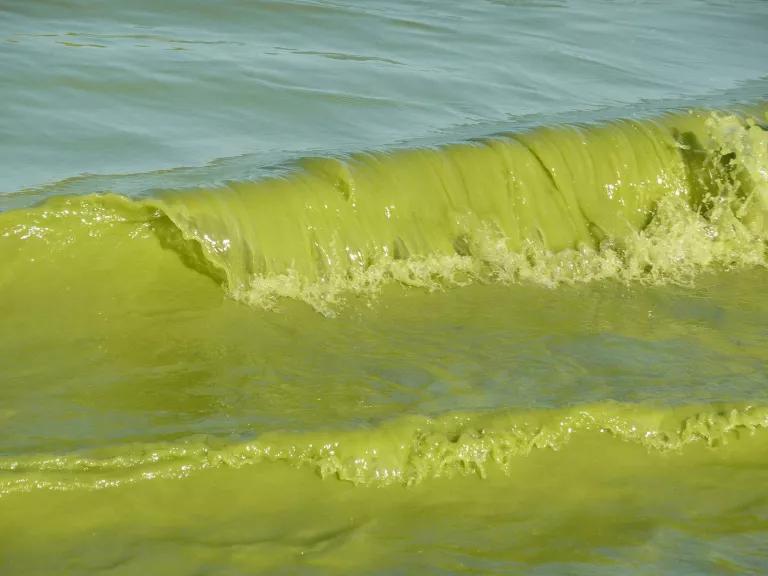The First Step Is Admitting You Have a Problem
The EPA won’t acknowledge nutrient pollution from farms and sewage, because then it would have to do something about it.

Six years ago, as part of the federal rulemaking process, environmental groups posed a simple question to the U.S. Environmental Protection Agency: Does it need to regulate nutrient levels in rivers and streams in order to meet the requirements of the Clean Water Act?
Everyone already knows the answer, of course—and yet we're still fighting about it. A federal appeals court heard arguments in New Orleans just yesterday. But the facts are pretty simple: Nutrient pollution—the effluent from sewage treatment plants and fertilizer runoff from farms—promotes runaway algae growth in our waterways, which suffocates aquatic life and poisons our drinking water. Yeah, the Clean Water Act covers that.
The residents of Toledo, Ohio, understand this—an algal bloom in Lake Erie rendered their water undrinkable for a weekend last August. The people of Des Moines have been paying big bucks to avoid a similar fate this fall. Louisiana fishermen know it, too; rapidly proliferating algae kill off 5,000 square miles' worth of Gulf marine life each summer. Even Midwestern pet owners are aware of the problem; toxins from nutrient-fueled algae have killed dogs and other animals around the Great Lakes.
And yet the EPA continues to dodge this simple yes-or-no question. Denying the obvious problem wouldn’t pass the smell test. (The odor coming off some of these dead zones is pretty potent, by the way.) But admitting that the country needs concrete numerical limits on nutrient pollution would obligate the EPA, under the Clean Water Act, to “promptly prepare and publish proposed regulations” if, that is, “the Administrator determines that a revised or new standard is necessary.”
Such a determination would hardly be revolutionary. In fact, Bill Clinton’s EPA was prepared to issue those standards way back in 1998 when 40 percent of U.S. rivers, 51 percent of lakes, and 57 percent of estuaries were found to suffer from nutrient pollution.
The EPA ordered states to develop specific target ranges for phosphorous and nitrogen by 2000. That deadline came and went, so the agency issued a second deadline for 2003. That deadline passed as well, with only a single state (Wisconsin) in compliance. Instead of following through on its threat to impose a federal standard, the EPA sat on its hands. Why? Municipal sewage treatment plants balked at investing in better waste-processing technologies, and farmers didn’t want to improve their fertilizer management. The EPA chose not to confront those entrenched interests.
So now, instead of strict, federally enforced limits on nitrogen and phosphorous in our waterways, we have a hodgepodge of state-by-state rules. Most are “narrative standards”—largely unenforceable statements that nutrient concentrations shouldn’t “cause an imbalance in natural populations of aquatic flora and fauna.”
The EPA says it has a collaborative relationship with state environmental management authorities on nutrient pollution, which is an awfully nice way of describing the situation. In 2008, the agency asked states—politely and for the third time—to develop nutrient-reduction strategies by the end of 2013, including concrete numerical limits suited to individual bodies of water.

The results have been uninspiring. In a report released in September, the Inspector General noted that most of the states in the Mississippi River basin—where the problem is most pronounced—still have not developed adequate nutrient-reduction strategies, nor have they even committed to doing so in a reasonable time period.
In 2013 a federal court finally ordered the EPA to give the environmental groups a straight answer to the question asked in 2008. (NRDC, which publishes Earthwire, was one of the plaintiffs in that lawsuit.) The EPA, still desperately trying to avoid taking action, appealed the decision.
The list of folks who ran to the agency’s defense isn’t that surprising. The American Farm Bureau, the National Corn Growers Association, the National Pork Producers Council, and the Fertilizer Institute all submitted arguments to the court, and a pair of industry associations for municipal sewage treatment plants chimed in with testimony of their own.
The groups argue that nutrient pollution shouldn’t be regulated at the federal level because it’s a “uniquely local” problem—even though states have demonstrably failed to solve it. They also warned the court of “sweeping, if not catastrophic, regulatory consequences” should the EPA be required to answer the simple yes-or-no question posed six years ago.
The polluters are right about one thing. Getting this decision wrong would have sweeping consequences. In fact, we’ve already seen them: ocean dead zones, suffocated aquatic life, poisoned watersheds, and cities that can’t drink their water. Sounds plenty catastrophic already.
This article was originally published on onEarth, which is no longer in publication. onEarth was founded in 1979 as the Amicus Journal, an independent magazine of thought and opinion on the environment. All opinions expressed are those of the authors and do not necessarily reflect the policies or positions of NRDC. This article is available for online republication by news media outlets or nonprofits under these conditions: The writer(s) must be credited with a byline; you must note prominently that the article was originally published by NRDC.org and link to the original; the article cannot be edited (beyond simple things such grammar); you can’t resell the article in any form or grant republishing rights to other outlets; you can’t republish our material wholesale or automatically—you need to select articles individually; you can’t republish the photos or graphics on our site without specific permission; you should drop us a note to let us know when you’ve used one of our articles.

Three Ways We Can Make Schools Healthier This Year
The Smart Seafood and Sustainable Fish Buying Guide
Neonicotinoids 101: The Effects on Humans and Bees